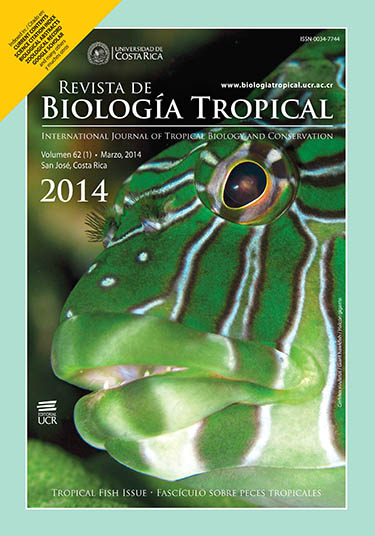Abstract
Geobatrachus walkeri is a frog that belongs to a monotypic genus and is endemic to the Sierra Nevada de Santa Marta, Colombia. The species habits different microhabitats between 2 000 to 3 500m altitude, including the leaf litter of a pine plantation. To understand its reproductive ecology, we conducted eight frog samplings, covering the rainy and dry seasons, and two habitat types (secondary native forest and pine plantation) during 2010-2011. For this study, we also included data obtained from five previous similar samplings undertaken during 2008-2009. The pine leaf litter was the main microhabitat where frogs were found; we heard choruses of six-ten calling males during all sampled months, and observed the frogs having diurnal and nocturnal activity. Regardless of the year of study, the population consisted of neonates recruited several times of the year, a large number of juveniles with a wide range of body sizes, and fewer adults with a narrower range of body size. The histological analyses of the gonads showed that the size at maturity was near 18mm SVL for males and females, and those adult males and females were reproductive active during all sampling months, suggesting a continuous reproductive activity pattern. However, during the dry season, the seminiferous tubules showed a drastically diminished spermatic epithelium although containing abundant luminal spermatozoa, which suggest a reduction in the sperm production at the end of this season. Similarly, frogs of all age categories were significantly more abundant during the early dry season, whereas were significantly less abundant with the advancement of the dryness suggesting that the intensity of the dry season could temporally stop the activity and reproduction of this populationGeobatrachus walkeri is a frog that belongs to a monotypic genus and is endemic to the Sierra Nevada de Santa Marta, Colombia. The species habits different microhabitats between 2 000 to 3 500m altitude, including the leaf litter of a pine plantation. To understand its reproductive ecology, we conducted eight frog samplings, covering the rainy and dry seasons, and two habitat types (secondary native forest and pine plantation) during 2010-2011. For this study, we also included data obtained from five previous similar samplings undertaken during 2008-2009. The pine leaf litter was the main microhabitat where frogs were found; we heard choruses of six-ten calling males during all sampled months, and observed the frogs having diurnal and nocturnal activity. Regardless of the year of study, the population consisted of neonates recruited several times of the year, a large number of juveniles with a wide range of body sizes, and fewer adults with a narrower range of body size. The histological analyses of the gonads showed that the size at maturity was near 18mm SVL for males and females, and those adult males and females were reproductive active during all sampling months, suggesting a continuous reproductive activity pattern. However, during the dry season, the seminiferous tubules showed a drastically diminished spermatic epithelium although containing abundant luminal spermatozoa, which suggest a reduction in the sperm production at the end of this season. Similarly, frogs of all age categories were significantly more abundant during the early dry season, whereas were significantly less abundant with the advancement of the dryness suggesting that the intensity of the dry season could temporally stop the activity and reproduction of this population.##plugins.facebook.comentarios##
Downloads
Download data is not yet available.






